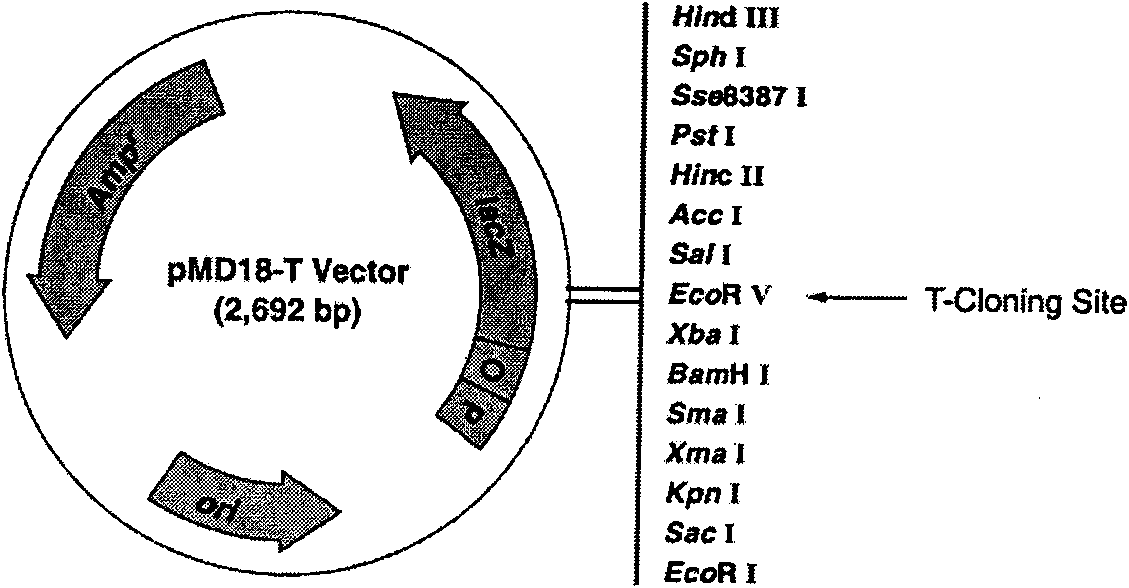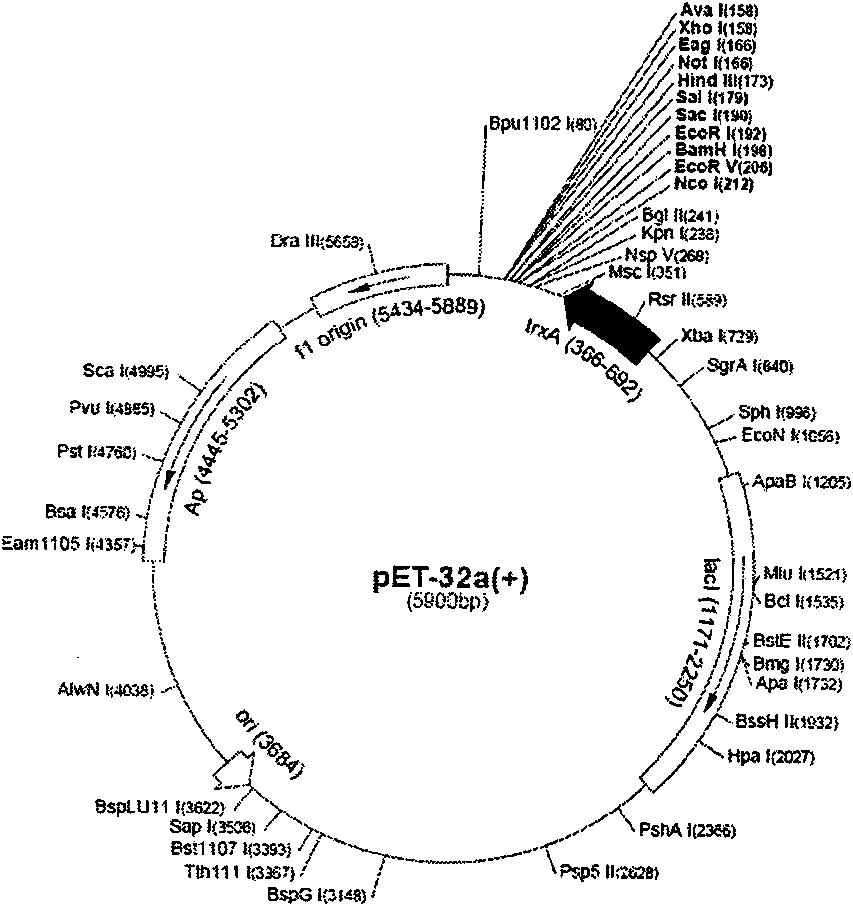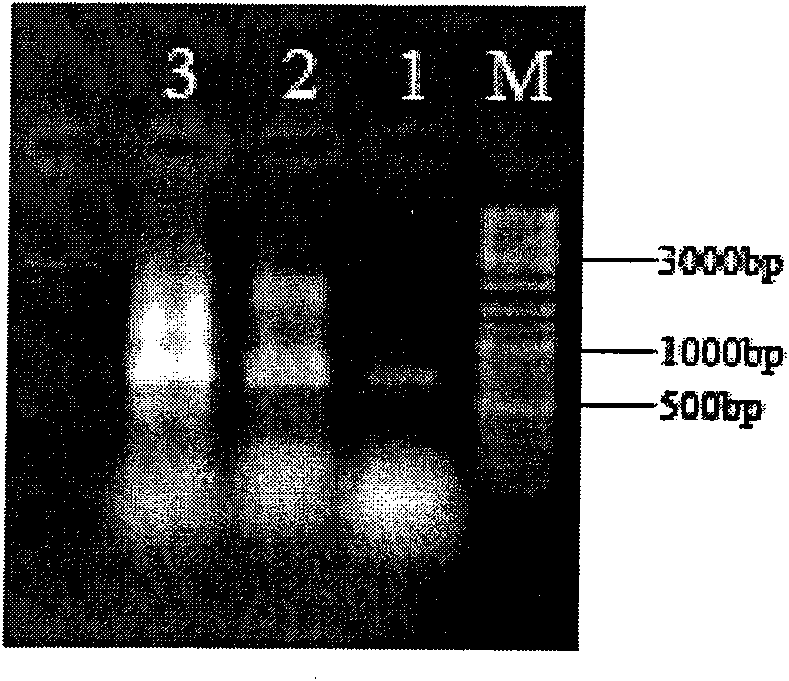Amino acid sequence, gene sequence and expression vector of heat shock protein HmHSP 70 of hypsizygus marmoreus
A gene sequence, heat shock protein technology, applied in the field of molecular biology
- Summary
- Abstract
- Description
- Claims
- Application Information
AI Technical Summary
Problems solved by technology
Method used
Image
Examples
Embodiment 1
[0114] Embodiment 1: Cloning the middle fragment of the HmHSP70 gene of jiji mushroom
[0115] Step 1. Inoculate the female species (spores) of Pleurotus jimeji mushroom on the PDA plate, cultivate it at 25°C until the plate is full, and collect the mycelium. Using the CTAB method to extract genomic DNA, referring to the method of Shangguan Zhoujian et al. (Shangguan Zhoujian, Xie Baogui, Luo Lianzhong, etc. RAPD analysis of three selected strains of jiji mushrooms [J]. Chinese Edible Fungi, 2004, 3(23) : 12~14), and save it for future use.
[0116] Step 1. Design degenerate primers
[0117] Log in to the GenBank / DDBJ / EMBL database, and use Primer Premier5.0 to combine DNAMAN6. 0 program to design a pair of degenerate primers:
[0118] P1: 5'-GCTGTHRTYACHGTYCCAGCTTAYTTC-3'
[0119] P2: 5'-RGCDACRGCYTCRTCNGGRTTRAT-3'
[0120] The above primers were synthesized by Shanghai Sangon Bioengineering Co., Ltd., and the primers were diluted to 20 μmol L with sterile double-distill...
Embodiment 2
[0171] Example 2. Cloning of fragments at both ends of the HmHSP70 gene of Shimeji mushroom.
[0172] Step 1. Design specific primers
[0173] According to the sequencing result Seq ID No 1, use Primer Premier5.0 combined with DNAMAN6.0 program to design specific primers for both end fragments of the HmHSP70 gene:
[0174] P 3 : 5'-CAACGACAGGCTACTAAGGATGCTGG-3'
[0175] P 4 : 5'-ACACGGGGCACACGAGTCATACC-3'
[0176] The above primers were synthesized by Shanghai Sangon Bioengineering Service Technology Co., Ltd., and the primers were diluted to 20 μmol L with sterile double-distilled water before use. -1 .
[0177] Step 2 Extraction of total RNA from Shijiji mushroom
[0178] Total RNA was extracted by Trizol method. The operation is as follows.
[0179] 1. Preparation before RNA extraction
[0180] The pipette tip, EP tube, mortar, spoon and pestle used for RNA extraction should be processed before RNA extraction. All the utensils used in the experiment were treated w...
Embodiment 3
[0245] Example 3. Amplification of the Complete Reading Frame of the Mushroom HmHSP70 Gene
[0246] Step 1 Design full-length gene-specific primers to amplify the full-length gene
[0247] Using DNAMAN software to analyze the sequencing results of 3'RACE and 5'RACE products, splicing into the full sequence of HSP70, removing the linker sequence added by the RACE reaction, and according to the overlapping sequence of the 5' and 3' ends, a full-length splicing of the HSP70 gene was obtained The sequence of 2308bp is shown as SEQ ID NO4; the reading frame analysis of the full-length cDNA sequence was carried out by using the ORF finder software of NCBI. 2001bp, such as SEQ ID NO 7, encoding 667 amino acids, as shown in SEQ ID NO6.
[0248] According to SEQ ID NO4, use Primer Premier5.0 combined with DNAMAN6.0 program to design full-length specific primers to amplify the complete reading frame of the gene.
[0249] The primer design sequence is:
[0250] HSPORF1:5'-CCC AAGCTT...
PUM
| Property | Measurement | Unit |
|---|---|---|
| molecular weight | aaaaa | aaaaa |
| molecular weight | aaaaa | aaaaa |
| molecular weight | aaaaa | aaaaa |
Abstract
Description
Claims
Application Information
 Login to View More
Login to View More - R&D
- Intellectual Property
- Life Sciences
- Materials
- Tech Scout
- Unparalleled Data Quality
- Higher Quality Content
- 60% Fewer Hallucinations
Browse by: Latest US Patents, China's latest patents, Technical Efficacy Thesaurus, Application Domain, Technology Topic, Popular Technical Reports.
© 2025 PatSnap. All rights reserved.Legal|Privacy policy|Modern Slavery Act Transparency Statement|Sitemap|About US| Contact US: help@patsnap.com



